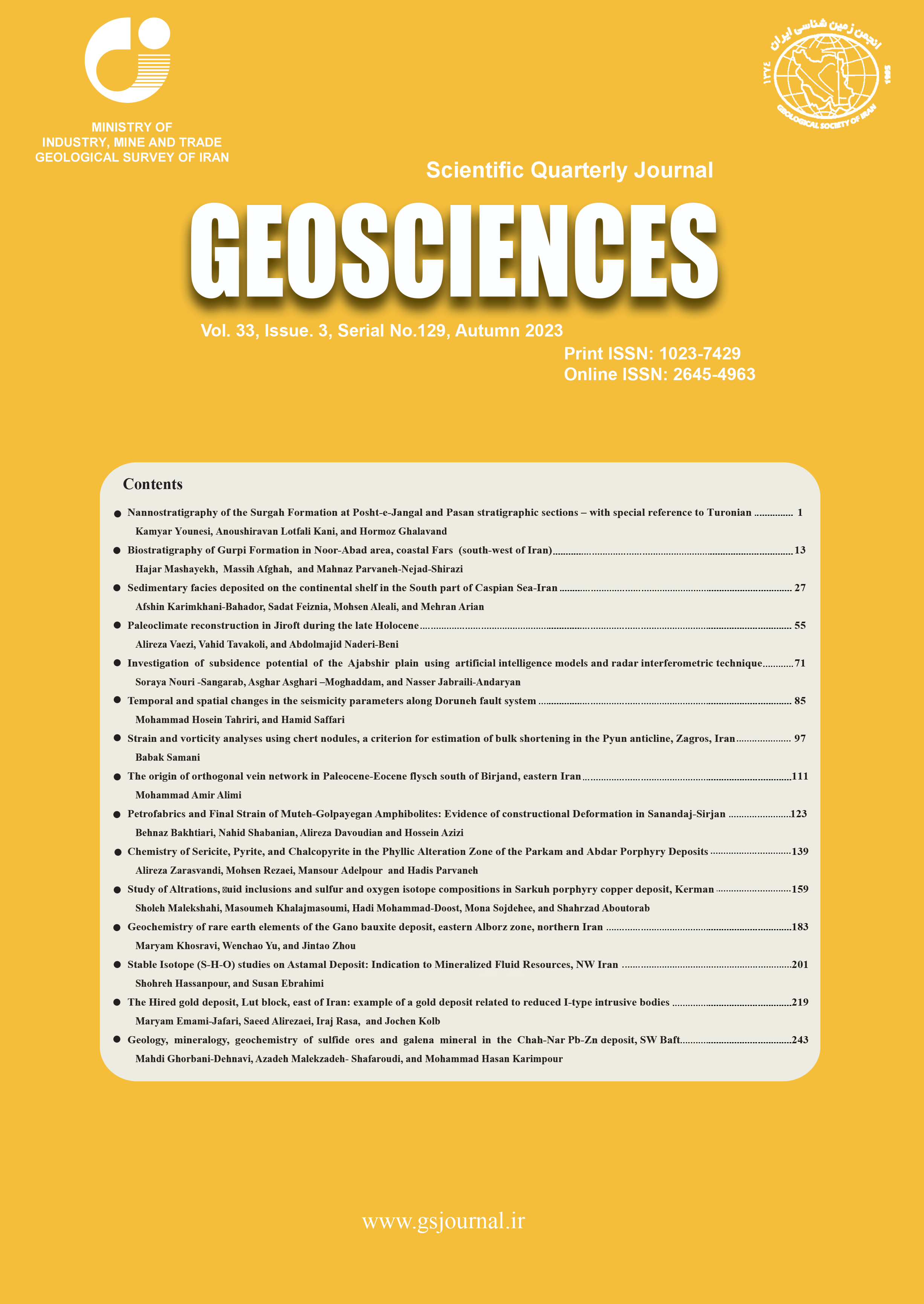Aki, K. ,1965. Maximum Likelihood Estimate of b in the Formula Log N= A-BM and Its Confidence Limits. Bull. Earthquake Res. Inst., Tokyo Univ. 43:237–39.
Bender, B., 1983. Maximum Likelihood Estimation of b Values for Magnitude Grouped Data. Bulletin of the Seismological Society of America 73(3):831–51.
Chen, J., and Zhu, Sh., 2020. Spatial and Temporal B-Value Precursors Preceding the 2008 Wenchuan, China, Earthquake (Mw = 7.9): Implications for Earthquake Prediction. Geomatics, Natural Hazards and Risk 11(1):1196–1211. doi: 10.1080/19475705.2020.1784297.
El-Isa, Z. H., and Eaton, D. W., 2014. Spatiotemporal Variations in the B-Value of Earthquake Magnitude-Frequency Distributions: Classification and Causes. Tectonophysics 615–616:1–11. doi: 10.1016/j.tecto.2013.12.001.
Farbod, Y., Bellier, O., Shabanian, E., and Abbassi, M. R., 2011. Geomorphic and Structural Variations along the Doruneh Fault System (Central Iran). Tectonics 30(6).
Fattahi, M., Walker, R. T. , Khatib, M. M., Dolati, A., and Bahroudi, A., 2007. Slip-Rate Estimate and Past Earthquakes on the Doruneh Fault, Eastern Iran. Geophysical Journal International 168(2):691–709. doi: 10.1111/j.1365-246X.2006.03248.x.
Goldstein, M. L., Morris, S. A., and Yen, G. G., 2004. Problems with Fitting to the Power-Law Distribution. European Physical Journal B 41(2):255–58. doi: 10.1140/epjb/e2004-00316-5.
Gutenberg, B., and Richter, C. F. 1944. Frequency of Earthquakes in California. Bulletin of the Seismological Society of America 34(4):185–88.
Li, Q., 1978. Time and Space Scanning of the B-Value-a Method for Monitoring the Development of Catastrophic Earthquakes. Acta Geophys. Sinica 21:101–25.
Main, I. 2000. Apparent Breaks in Scaling in the Earthquake Cumulative Frequency-Magnitude Distribution: Fact or Artifact?. Bulletin of the Seismological Society of America 90(1):86–97. doi: 10.1785/0119990086.
McGuire, R. K., and Arabasz., W. J., 1990. An Introduction to Probabilistic Seismic Hazard Analysis. Pp. 333–54 in Geotechnical an Environmental Geophysics: Volume I: Review and Tutorial. Society of Exploration Geophysicists.
Mousavi, Z., Fattahi, M., Khatib, M., Talebian, M., Pathier, E., Walpersdorf, A. , Sloan, R. A., Thomas, A. L., Rhodes, E., and Clive, F., 2021. Constant Slip Rate on the Doruneh Strike-Slip Fault, Iran, Averaged Over Late Pleistocene, Holocene, and Decadal Timescales. Tectonics 40(6):e2020TC006256.
Nakaya, S. 2006. Spatiotemporal Variation in b Value within the Subducting Slab Prior to the 2003 Tokachi-Oki Earthquake (M 8.0), Japan. Journal of Geophysical Research: Solid Earth 111(3):1–13. doi: 10.1029/2005JB003658.
Nava, F. A., Márquez-Ramírez, V. H., Zúñiga, F. R., Ávila-Barrientos, L., and Quinteros, C. B., 2017. Gutenberg-Richter b-Value Maximum Likelihood Estimation and Sample Size. Journal of Seismology 21(1):127–35. doi: 10.1007/s10950-016-9589-1.
Newman, M. E. J., 2005. Power Laws, Pareto Distributions and Zipf’s Law. Contemporary Physics 46(5):323–51. doi: 10.1080/00107510500052444.
Nuannin, P., Kulhanek, O., and Persson, L., 2005. Spatial and Temporal b Value Anomalies Preceding the Devastating off Coast of Sumatra Earthquake of December 26, 2004. Geophys. Res. Letters (11):1–4.
Scholz, C. H., 1968. The Frequency-Magnitude Relation of Microfracturing in Rock and Its Relation to Earthquakes. Bulletin of the Seismological Society of America 58(1):399–415. doi: 10.1785/bssa0580010399.
Shahvar, M. P., Zare, M., and Castellaro, S., 2013. A Unified Seismic Catalog for the Iranian Plateau (1900-2011). Seismological Research Letters 84(2):233–49. doi: 10.1785/0220120144.
Sheikholeslami, M, R., Javadi, H, R., Asadi Sarshar, M., Agha Hosseini, A., Koupeyma, M., Vahdati Daneshmand, B., 2014. Iran faults Encyclopedia, Geological Survey of Iran & Rahi publication. (In Persian).
Shi, Y., and Bolt, B. A., 1982. The Standard Error of the Magnitude-Frequency b Value. Bulletin of the Seismological Society of America 72(5):1677–87.
Tsukakoshi, Y., and Shimazaki, K., 2008. Decreased B-Value Prior to the M 6.2 Northern Miyagi, Japan, Earthquake of 26 July 2003. Earth, Planets and Space 60(9):915–24. doi: 10.1186/BF03352847.
Utsu, T. , 1965. A Method for Determining the Value of b in a Formula Log N= A= BM Showing the Magnitude Frequency Relation for Earthquakes. Geophys. Bull. Hokkaido Univ. 13:99–103.
Wellman, H. W., 1966. Active Wrench Faults of Iran, Afghanistan and Pakistan. Geologische Rundschau55(3):716–35. doi: 10.1007/BF02029650.
Wiemer, S., 1996. Analysis of Seismicity: New Techniques and Case Studies. Dissertation Thesis, University of Alaska.
Wiemer, S., and Wyss, M., 2000. Minimum Magnitude of Completeness in Earthquake Catalogs: Examples from Alaska, the Western United States, and Japan. Bulletin of the Seismological Society of America 90(4):859–69. doi: 10.1785/0119990114.
Wiemer, S. ,2001. A Software Package to Analyze Seismicity: ZMAP. Seismological Research Letters 72(3):373–82. doi: 10.1785/gssrl.72.3.373.
Wiemer, S., and Benoit, J.P., 1996. Mapping the B-value Anomaly at 100 Km Depth in the Alaska and New Zealand Subduction Zones. Geophysical Research Letters 23(13):1557–60.
Wiemer, S., and Wyss, M., 1997. Mapping the Frequency‐magnitude Distribution in Asperities: An Improved Technique to Calculate Recurrence Times?. Journal of Geophysical Research: Solid Earth 102(B7):15115–28.
Woessner, J., and Wiemer, S., 2005. Assessing the Quality of Earthquake Catalogues: Estimating the Magnitude of Completeness and Its Uncertainty. Bulletin of the Seismological Society of America 95(2):684–98.
Wu, K. T., Yue, M. S., Wu, H. Y., Chao, S. L., Chen, H. T. , Huang, W. Q. , Tien, K. Y. , and Lu, S. D., 1978. Certain Characteristics of the Haicheng Earthquake (M= 7.3) Sequence. Chinese Geophysics, AGU 1:289–308.
Xie, Zh., Lyu, Y., and Li, X., 2022. Temporal and Spatial Changes in the B-Value Prior to the 2021 Luxian M S 6.0 Earthquake in Sichuan, China. Geomatics, Natural Hazards and Risk 13(1):934–48. doi: 10.1080/19475705.2022.2059019.
Zöller, G., Hainzl, S., Kurths, J., and Zschau, J., 2002. A Systematic Test on Precursory Seismic Quiescence in Armenia. Natural Hazards 26(3):245–63. doi: 10.1023/A.

